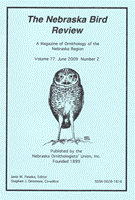Nebraska Ornithologists' Union

Nebraska Bird Review
Date of this Version
6-2018
Document Type
Article
Citation
The Nebraska Bird Review Vol. 86 No. 2 (2018), pp 50-89
Abstract
This spring will be remembered for Nebraska’s first unequivocal record of Swainson’s Warbler, unfortunately a “one day wonder”, but well-photographed. Another mega was a Band-tailed Pigeon, Nebraska’s fourth. The old sports saying “wait until next year” was applicable in spades to woodwarblers; last year was noted for its paucity of most species of wood-warblers, but this year, incredible record numbers occurred for several migrant species: Magnolia, Baybreasted, Chestnut-sided, Blackpoll, and Palm. Other amazing numbers were the 598,000 Sandhill Cranes counted at peak migration in the Central Platte Valley and the 598 Great Egrets reported within the amazing 414 reports. Several species continue to expand ranges and increase in numbers; now almost ubiquitous is White-winged Dove, which is establishing a pattern of summer residency, albeit with as yet few records of nesting, and Lesser Black-backed Gull, now a regular migrant in the state. Osprey continues breeding successfully in the west, with new sites in Scotts Bluff and Keith Cos. Barred Owl is moving west with alacrity in riparian drainages; one was photographed at North Platte, the westernmost location to date, and Pileated Woodpecker appeared at two extreme northeastern locations, the northernmost to date in the Missouri River Valley. Important nesting reports were of Black-billed Magpies nesting in Pierce Co, hopefully maintaining the small disjunct population there, and a pair of Pine Siskins with a newly-fledged juvenile in Lincoln, one of a number of far-flung breeding records for this species. As in each season, there were a few reports of distributional significance. Two adult Mew Gulls were reported, unusual in spring. A Rocky Mountain Downy Woodpecker, subspecies Picoides pubescens leucurus, with completely black wings and shoulders, was found at Fort Robinson, Dawes Co; it was hanging out with the expected eastern subspecies P. p. medianus. An excellent photograph of a grayflanked Hermit Thrush as far east as Antelope Co was almost certainly another Rocky Mountain subspecies, Catharus gutatus auduboni. A persistent green-backed male Lesser Goldfinch returned to the same feeder it attended in winter 2016-2017; good photos were taken of this bird, representing the first eastern winter record and only the fourth for winter overall. Finally, a Sterna tern at Lake Ogallala caused identification heartburn; experts disagreed as to whether it was an Arctic or a Common.
Included in
Ornithology Commons, Population Biology Commons, Poultry or Avian Science Commons, Zoology Commons


Comments
Published by the Nebraska Ornithologists’ Union, Inc.